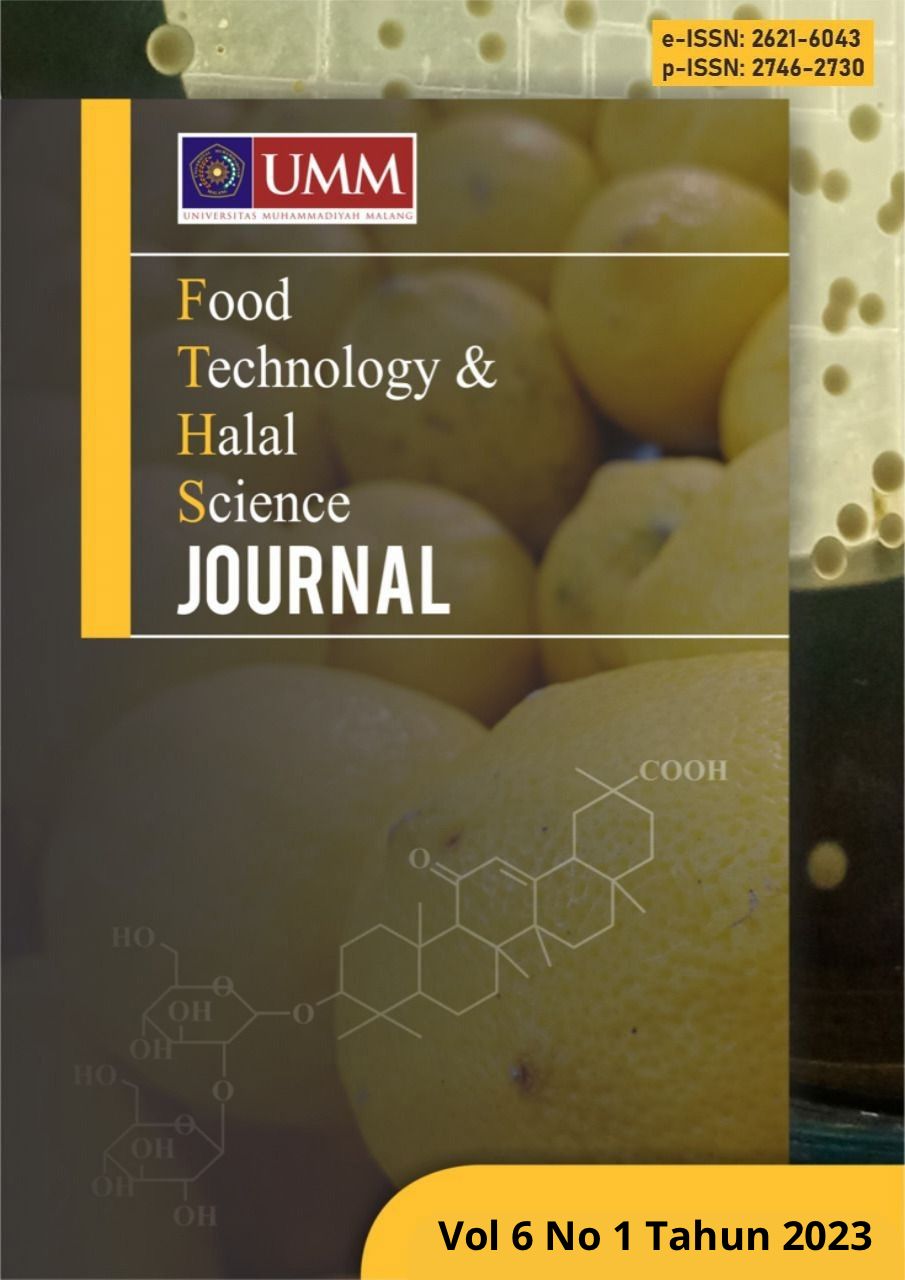Pengaruh Proporsi Angkak (Red Mold Rice) Terhadap Karakteristik Fisikokimia dan Organoleptik Sosis Ikan Nila
DOI:
https://doi.org/10.22219/fths.v6i1.28336Keywords:
tilapia sausage, angkakAbstract
The boiling process causes the color of the meat in the sausage to fade, so efforts are needed to improve the color of tilapia sausage using natural dyes that are safe for consumption. The addition of angkak was chosen for food coloring so that it can affect the level of consumer acceptance. The purpose of this study was to determine the effect of the addition of angkak proportion on the physicochemical characteristics and organoleptic score of tilapia sausage produced. The treatment added is the proportion of angkak which consists of 6 concentrations, namely 0%, 0.5%, 1%, 1.5%, 2% and 2.5% (% calculated from the total weight of tilapia and tapioca flour). The test parameters were water content, fat content, protein content, antioxidant activity, color intensity, hardness, and organoleptic test of taste, aroma, color, and texture. The best treatment was tilapia sausage with the addition of 1.5% angkak proportion (A3) with an average moisture content of 61.85%; protein 15.87%; fat 15.35%; antioxidant activity 40.49%; texture hardness 31.59 N; color intensity: brightness (L) 44.85; redness (a) 23.37; yellowness (b) 13.05; organoleptic: color 4.23 (red); taste 3.86 (moderately savory); aroma 2.63 (not fishy); texture 4.43 (chewy).
Keywords: tilapia sausage, angkak
Downloads
References
Atma, Y. (2015). Studi Penggunaan Angkak Sebagai Pewarna Alami Dalam Pengolahan Sosis Daging Sapi. Jurnal Teknologi 7, no. 2: 76–85. https://doi.org/10.24853/jurtek.7.2.76-85.
Badan Standardisasi Nasional (BSN). (1995). SNI No 01-3820-1995: Sosis Daging. Jakarta: Badan Standarisasi Nasional.
Kumari, H.P. Mohan, K.A. Naidu, S. Vishwanatha, K. Narasimhamurthy and G. Vijayalakshmi. (2019). Safety Evaluation of Monascus Purpureus Red Mould Rice Inalbino Rats. Food and Chemical Toxicology 47: 1739-1746
Liu, D.C., S.W. Wu and F.J. Tan. (2013). Effects of Addition of Anka Rice on the Qualities of Low-nitrite Chinese Sausages. Food Chemistry 118: 245- 250.
Nalendrya, I., I. M. B, Ilmi dan F. A. Arini. (2016). Sosis Ikan Kembung (Rastreligger Kanagurta L.) Sebagai Pangan Sumber Omega 3. Fakultas Ilmu-Ilmu Kesehatan. Universitas Pembangunan Nasional “Veteran”. Jakarta. Vol. 15, No. 5: 897 – 904.
Natasya, R. (2019). Karakteristik Sensoris Dan Fisiokimia Sosis Lele Dumbo (Clarias Gariepinus) Yang Dibuat Dengan Variasi Jenis Dan Konsentrasi Bahan Pengikat. Vol. 1, No. 5: 297 – 324.
Pandiangan, J.F.E., I.N.K Putra., I.D.P.K Pratiwi. (2019). Pemamfaatan Angkak Sebagai Pewarna Alami dan Antioksidan Sosis Ikan Kembung (Rastrelligerkanagurta L.). Jurnal Teknologi Pangan. V0l 8, No 2.
Pratiwi, DH, Andriani, Edhi N. (2017). Pengaruh Penambahan Bit (Beta Vulgaris L.) Sebagai Pewarna Alami Dan Bahan Pengisi Terhadap Karakteristik Fisikokimia Dan Sensori Sosis Nabati. Jurnal Teknosains Pangan 2, no. 4: 20–35. www.ilmupangan.fp.uns.ac.id.
Rachmawati, AF., Radiati, LE., Thohari I. (2016). Tingkat Penggunaan Ekstrak Angkak (Monascus Purpureus) Sebagai Curing Alternatif Dengan Metode Curing Basah Terhadap Kualitas Kornet Daging Sapi. fapet.ub.ac.id. Vol. 16 (1):441-462.
Rahingtyas, R. S., Anuradha D., Gunjan, T. and Shweta S. (2018). Qualitative Characteristics of Red Mold Rice and White Rice Procured from Local Market of Uttarakhand: A Comparative Study. Department of Foods and Nutrition, College of Home Science, G.B. Pant University of Agriculture and Technology. Journal of Rice Research 2017, Vol 10 No. 1: 565-580.
Sari, M., Lestari, D.A., dan Sayekti, W. (2021). Keragaan Agroindustri Dan Posisi Produk Berdasarkan Siklus Hidup Produk Pada Sosis Gulung Varian Noodle Di CV Cucurutuku Ceria. Jurnal Ilmu Ilmu Agribisnis : Journal of Agribusiness Science 9(4), no. 3: 561–68.
Souripet, A. (2015). Composition, Physical Properties and Preferred Level of Purple Rice. Jurnal Teknologi Pertanian. Volume 4, No. 1: 43-51
Sukardi, Damat, Manar F. M. A, Lili Z., Rahayu R., Asad, Zane V, Effendi A., and Warkoyo. (2022). Chemical Compounds, Antioxidant Properties, and Enzyme Inhibitory Activities of Kitolod Leaf and Fruit Hexane Extracts as Antidiabetic. Jordan Journal of Biological Sciences. Vol. 15, No. 5: 897 – 904
Trisnadjadja, D., K. Irawan dan Bustanussalam. (2016). Pengkajian Aktivitas Antioksidan Dari Beras Merah Hasil Fermentasi (Angkak). Pusat Penelitian Bioteknologi-LIPI: Bogor. Vol.2(1): 3-12.
Yanli F and Xiang Y. (2020). Perspectives on Functional Red Mold Rice: Functional Ingredients, Production, and Application. Front Microbiol. Vol.5(2):13-17.
Zahrat, El-Ola M., Ghada H. H. Ismaiel. (2016). Quality Characterizations of Pasta Fortified with Red Beet Root and Red Radish. International Journal of Food Science and Biotechnology. 1(1):1-7.
Downloads
Published
How to Cite
Issue
Section
License
Copyright (c) 2024 Jihan Lisa Puspitasari Qois, Sukardi, Rista Anggriani

This work is licensed under a Creative Commons Attribution 4.0 International License.
Authors who publish with this journal agree to the following terms:
- Authors retain copyright and grant the journal right of first publication with the work simultaneously licensed under a Creative Commons Attribution License that allows others to share the work with an acknowledgement of the work's authorship and initial publication in this journal.
- Authors are able to enter into separate, additional contractual arrangements for the non-exclusive distribution of the journal's published version of the work (e.g., post it to an institutional repository or publish it in a book), with an acknowledgement of its initial publication in this journal.
- Authors are permitted and encouraged to post their work online (e.g., in institutional repositories or on their website) prior to and during the submission process, as it can lead to productive exchanges, as well as earlier and greater citation of published work (See The Effect of Open Access).










